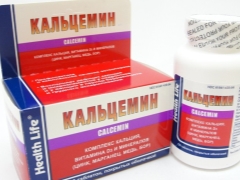Calcemin for children
For full growth, children need many nutrients, one of which is calcium. If it is not possible to ensure its delivery with food, they resort to supplements and vitamin preparations. One of these tools can be called Calcemin. Is it permitted for children and at what dose is it used in childhood?
Release form
Kalzemin is a product of the German company Bayer, but in pharmacies it can be found in two different packages.
In addition to being produced in Germany, there is also an additive from Health Life.. It is manufactured in the United States by Sagmel, which Bayer bought, so both drugs are identical and differ only in inactive components in the composition, due to which the tablets have white color and convex on both sides oval shape. One pack includes 30, 60 or 120 tablets.
Dr. Komarovsky will talk about why children need calcium so much in the next video.
Composition
The active components of the drug are:
- Calcium, presented in the form of two compounds - citrate and carbonate. Only 1 tablet is a source of 250 mg of calcium.
- Vitamin D3 at a dosage of 50 IU per 1 tablet.
- Zinc oxide, from which the patient receives 2 mg of zinc from one tablet.
- Copper oxide, which gives 500 µg of copper in each tablet.
- Manganese is in the form of sulphate, which contains 500 µg per tablet.
- Sodium borate, which is a source of 50 µg of boron in 1 tablet.
These compounds are supplemented with stearic acid, maltodextrin, microcrystalline cellulose, soy polysaccharides, magnesium silicate, polyethylene glycol and other substances.
Operating principle
Calcemin affects the exchange of calcium and phosphorus, preventing or eliminating the lack of such elements. The drug is important for the normal formation of bones, strengthen joints and teeth. Minerals in its composition are involved in the formation of hormones, elastin and collagen.
Indications
Supplement prescribed for deficiency of calcium and vitamin D3, as well as other trace elements important for bones and teeth. The drug is in demand during the period of active growth in children, after fractures and with insufficient nutrition.
From what age is taken
Calcemin is prescribed for children over 5 years.
Contraindications
The drug should not be given to a child if he has such problems identified:
- Intolerance to any of its ingredients.
- Hypervitaminosis D.
- Urolithiasis disease.
- Hypercalcemia.
- Hypercalciuria.
- Severe renal failure.
- Active tuberculosis.
Side effects
Occasionally, nausea, allergies, abdominal distension, and other negative symptoms may occur when taking Calcemin. If they have a child, you should immediately notify the doctor.
Instructions for use
In order to absorb the active ingredients of Calcemin better, it should be taken with meals. The dosage for a child of 5-12 years is 1 tablet per day. Adolescents 12 years and older are advised to take one tablet twice a day. Typically, the tool is recommended to take 2-3 months, after which a break for at least 1 month.
What causes calcium deficiency in the children's body will tell Dr. Komarovsky in the next video.
Overdose
Excess doses of Calcemin lead to the appearance of such negative symptoms on the part of the gastrointestinal tract as nausea, constipation or vomiting. Excessive intake of calcium will also affect the absorption of iron and some other minerals.In addition, due to overdose, the level of calcium in the blood rises, so this element is excreted in greater quantity with urine and accumulates in soft tissues. This can lead to damage to the blood vessels, kidneys and heart.
Drug interaction
Calcemin should not be combined with laxative drugs, antacids, glucocorticoids, barbiturates, and some other medicines noted in the annotation.
Terms of sale and storage
To buy the drug at the pharmacy, showing a prescription from a doctor is not required. The average price of a pack of 30 tablets is 300 rubles. Keep Calzemin home is recommended at a temperature of +15 to +30 degrees in a dry place, where the additive will not be available for a small child. Shelf life of tablets - 3 years.
Reviews
There are many good reviews about the use of Calcemin, in which the additive is praised for availability in pharmacies, adequate price and good composition. The main disadvantage of the drug is called a large pill size. In addition, some children have constipation or nausea when taking it.
Analogs
A replacement for Calcemin may be the addition of Citra-Calcemine, which is also available from Bayer. In its composition, all calcium is calcium citrate, and the dosage of vitamin D is higher (125 IU in 1 tablet). Zinc and boron in this tool is also more, and besides them there is also magnesium. Supplement is recommended for strengthening cartilage, teeth and bones for children over five years old.
If the child is more than twelve years old, then the usual Calcemin can be replaced with Calcemin Advance. In such tablets, the doses of all active ingredients are increased. Taking 1 tablet per day, the child will receive 500 mg of calcium and 200 IU of vitamin D3.
In addition, instead of Calcemin, you can give children the following additives:
- Multi-tabs Calcium + chewable tablets, which are allowed from 2 years. They contain vitamin D, other vitamins, and minerals important for the development of children.
- Chewable Orange Flavored Tablets Calcium Comp3 D3. The basis of this supplement is calcium carbonate, to which 200 IU of vitamin D is added. The drug is prescribed from the age of 3.
- Multivitamin zheleyki Vitamishki Calcium +. Such chewy "cubs" contain calcium in the form of phosphate and vitamin D. They are allowed to give to children over 3 years old.
Children under 3 years old may be prescribed a Complite Calcium D3 suspension for babies. Having prepared a sweet syrup containing calcium carbonate and vitamin D from powder, it can even be given to a baby as prescribed by a doctor.





















